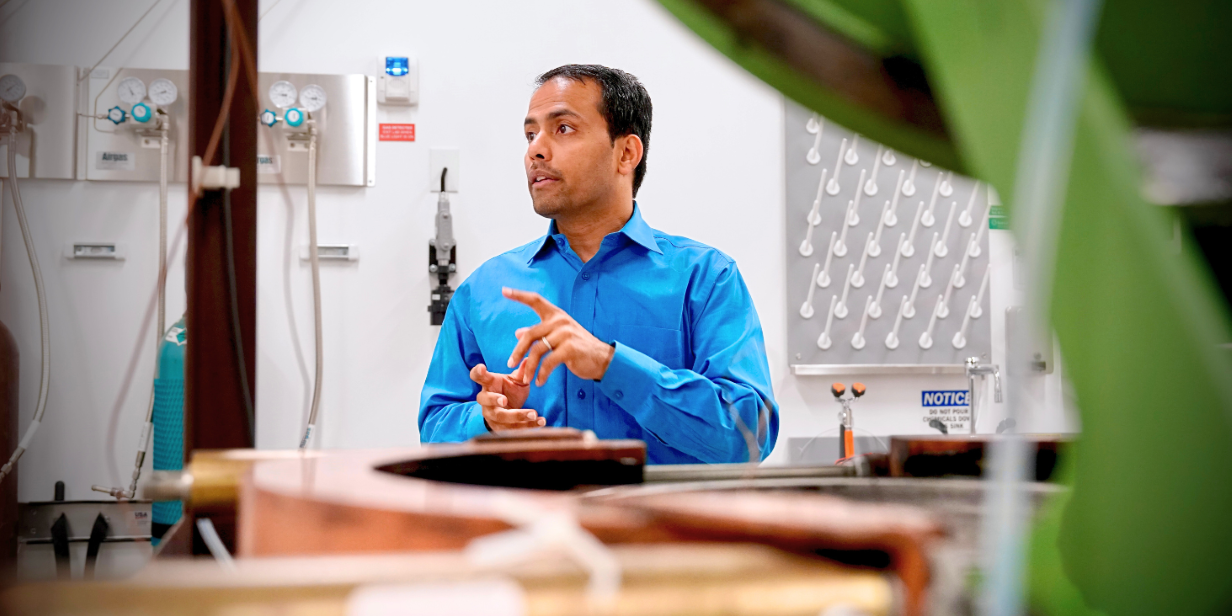Why this technology is a ‘big deal’ for data centers, battery energy storage systems and more
Data centers and battery energy storage systems are some of the potential areas where off-gas detection could be useful.

Back in 2020, a team of researchers at FM started experimenting with lithium-ion batteries in the safe confines of a lab in ways that you couldn’t do anywhere else.
They would slip the batteries into metal tubes, then wrap those tubes with heating pads. Or they would hook them up to wires, sending a high electrical voltage coursing through them. They would then close the safe testing chamber and wait, sometimes for an hour or more, until they heard a telltale pop and hiss.
They did this dozens of times over the course of several months, all to answer a pressing question for businesses around the globe: Can you detect a precursor to lithium-ion battery fires and explosions—with enough time to prevent them?Sujit Purushothaman, the FM senior lead research engineer who led the study, still remembers the reaction of a colleague when he showed the results:
“Oh, it works!”
Yes, indeed. A paper that Purushothaman presented at an IEEE conference concluded that in some scenarios, products known as off-gas detectors can provide early enough warning to prevent a chain reaction called thermal runaway that leads to explosions and fires.
The testing Purushothaman conducted was the first independent evaluation of off-gas detection, helping make scientific progress on a major emerging risk.
“If someone makes a claim, our job is to evaluate that claim,” Purushothaman said.
For FM researchers like Purushothaman, evaluating claims goes beyond the theoretical. Several dozen lithium-ion batteries were harmed in the making of this research—pushed to the limit, and in some cases past the limit. The video below shows testing of a battery that went all the way into thermal runaway. It popped, hissed, and went boom.
This explosion in the safe confines of a lab is exactly what you don’t want happening at your business.
Three Things Businesses Should Know About Off-Gas Detection
1. How off-gas detection works
Most lithium-ion batteries—say, the one powering the computer you’re reading this on—carry out their task without causing any trouble. When they end up making headlines, it’s usually because of thermal runaway.
Thermal runaway is a chain reaction in damaged or defective batteries that leads to fires and explosions. Once thermal runaway starts, it can’t be stopped.
Off-gas detection works by sensing electrolyte vapors that a lithium-ion battery gives out in the minutes before it’s about to go into thermal runaway. (This off-gassing was the pop and hiss that FM’s researchers were waiting for; the boom was thermal runaway.) Purushothaman was supported in this work by consultant engineers Anjali Rathesh and Jim Almeida.
More details on how FM’s research worked: Purushothaman’s team overcharged or overheated batteries in a testing chamber outfitted with off-gas detectors. Those detectors were able to pick up on the presence of off-gas vapors when the cell vented them. Shortly after the detectors went off, Purushothaman’s team stopped overcharging or overheating the batteries—and those batteries didn’t end up going into thermal runaway. The time gap between off-gassing and thermal runaway was anywhere from about five to 20 minutes.
2. Who might benefit from off-gas detection
Off-gas detection is a valuable safety measure in environments where lithium-ion batteries are used, including in battery energy storage system (BESS) applications, said Erik Verloop, principal engineer renewable energy at FM. But they could be useful anywhere you can think of that has exposure to lithium-ion batteries, like in data centers, Verloop said.
Data centers: Many modern data centers are moving towards uninterruptable power supply (UPS) using Li-ion battery modules in data processing equipment rooms, potentially exposing critical infrastructure to the risk of thermal runaway, fire, and toxic gas release if proper safety measures are not in place.
BESS: Thermal runaway is one of the most critical risks for energy storage developers and insurers, and high-capacity BESS, especially in densely populated or enclosed environments, has amplified the urgency for robust risk mitigation strategies.
FM’s continuing research enables us to regularly enhance our Property Loss Prevention Data Sheets, such as Data Sheet 5-33 Lithium-Ion Battery Energy Storage Systems, to support our clients and the broader industry in protecting critical assets and improving resilience, Verloop said.
FM also recently issued a first-of-its-kind data sheet on manufacturing and storing lithium-ion batteries. More information about the data sheet can be found here. And FM’s data sheet for data centers recommends FM Approved water mist systems for the protection of non-storage occupancies, hazard category 2 (HC-2) as a fire protection system option when lithium-ion battery backup units are present.
3. FM Approved lithium-ion off-gas detection
In 2025, this loss-prevention progress continued: FM Approvals, the third-party internationally recognized testing and certification arm of FM, announced a first-of-its-kind Approval of a Li-ion battery off-gas detector: Nexceris’ Lithium-Ion Battery Off-Gas Detector – Li-ion Tamer (LT-SEN-M). This system is appropriate for open spaces and is ideal to protect data center rooms.
Approvals also certified the Gen2+ system of the Li-ion Tamer, which offers a cost-effective solution for protecting small battery cabinets or enclosures and is ideal for applications such as data centers requiring localized battery protection.
“It's a big deal, because everything up to now has been focused on what do we do after the fire starts,” said Patrick Byrne, operations vice president, group manager at FM Approvals. “Now you're actually focusing on what do we do to prevent the fire from starting.”
Related content:
In May, FM announced Intellium, a program aimed at helping clients face a rapidly evolving risk environment fueled by the artificial intelligence (AI) and cloud computing boom—and the resulting data center and power generation needs these innovations require.
Learn more 